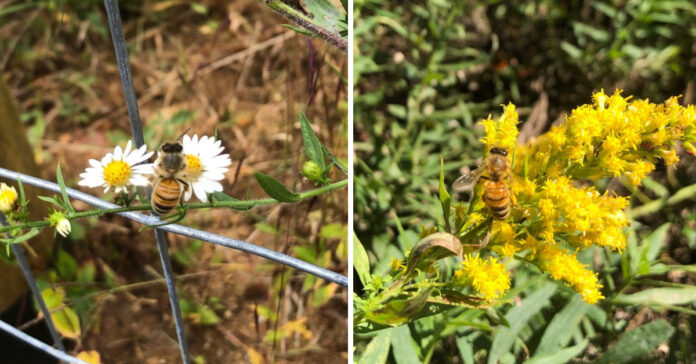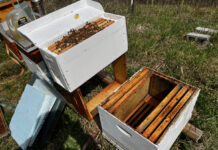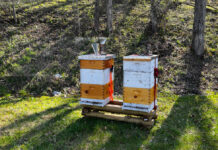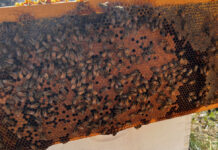The goldenrod and several varieties of aster have been blooming for a couple weeks, but I haven’t seen bees on them until this week.
Both flowers are known for providing bees with critical nectar and the pollen they need to bulk up their stores and get prepared for the winter. It’s possible last week’s rain washed out some resources, and they weren’t worth gathering from them until things dried up. It’s also possible that the Jewel Weed, the Iron Weed, and other flowers were a bigger draw for the bees. Now these plants have gone to seed, so the bees are focusing on the goldenrod and asters, which are among the final blooms of the season.
Just another sign that fall is here. Time to get the hives prepared.
What Bees Feed On
Every day I watch the bees zoom out of their hives. When there is a good nectar flow, they take off rapidly and head upwards, like fighter jets launching from an aircraft carrier. Some peel off to the left, some to the right, but most seem to go straight. Whichever way they go, they are too small and fast for me to track them beyond 40 or 50 feet.
Rarely do I know where they are going. I make assumptions based on what is blooming, but unless you see a honeybee on a flower, you are never 100 percent certain that is what they are visiting. Plus, our area is heavily wooded, so they are often foraging among the tree tops, well out of sight.
When I get close to the hive entrance, I can see the bees coming in for a landing, often with saddle bags filled with pollen. Today it is yellow, a sure sign of Goldenrod. Plus, some bees I see on the plants have the pollen stored on their hind legs.
There are charts you can find online to compare the color of the pollen they harvest and identify the plant it is from. That’s easy with something that is an unusual color, like blackberry pollen, but there are so many variations of yellow and orange that it is often impossible to be sure. This time, however, I have a high degree of confidence.
Planting Pollinators
We planted pollinators, but I think our bees prefer the weeds and wildflowers. As I understand it, bees want quantity, and there are so many wild flowers and weeds in our meadow, in the clear-cut areas under the power lines, and along the road. The flowers and flowering shrubs we planted cannot compete. We need to plant dozens of them. Perhaps we will add more next year. Or, in time, our plants may spread and become more of a resource for the bees.
Other bees, especially the humble bumble bee, like the pollinators we have planted, as do the many species of butterflies that visit our mountainside. Different bees have different lengths of proboscis, which allows them to harvest nectar from different plants. Bumblebees can feed on the pink clover while honeybees prefer white. Bumblebees also feast on our thistles, but I have never seen a honey bee on one. That’s OK with me; I am in favor of diversity of pollinator plants and a diverse population of bees and other pollinators. No monoculture here.
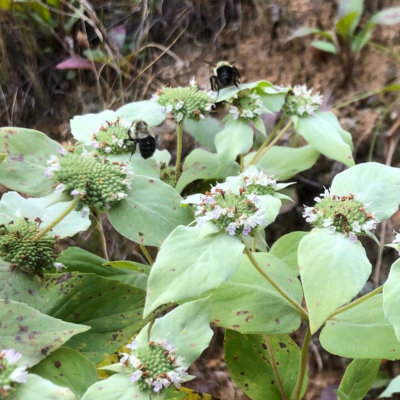
I am astounded at the variety of wild flowers and what many would consider weeds in our immediate area. My wife is astounded at the number of invasive species, like Japanese Knotweed and Stiltgrass, that are growing in what is undeveloped land. We don’t know if some old homesteaders planted these, like they did the apple trees, or if they started from seeds carried by birds or animals. It’s clear why they are considered invasive; they spread like wildfire, especially when given free range over a period of years.
2022 Bee Plans
I consider my 2021 beekeeping to have been a success. We established three hives and built them up to be quite large. We also harvested some honey, which exceeded my expectations. Most importantly, I have learned and become a better beekeeper. I am looking forward to next year.
I have already purchased two new nuc boxes and more deep hive bodies, and I will assemble them this winter. Also on the build list are more supers plus large and medium frames so I can hit the ground running. Hopefully, I will have enough drawn comb to give every split some drawn comb to help them get started.
I hope to have at least two hives make it successfully through the winter. If that is the case, I will make splits as soon as the hives are strong enough, perhaps as early as late April or May. I am planning to breed queens from our best performing hive and use these new queens to populate the new splits. Keeping “spare” queens in nucs also makes sense in case a hive goes queenless in the middle of the summer. If that happens, I can pop a spare queen into the hive and not lose a month.
I may also experiment with what some are calling the Comfort Hives, named after Sam Comfort or Anarchy Apiary. Sam raises thousands of queens a year and uses 11” x 11” hives built inexpensively from dimensional lumber. These are not ideal for producing honey that can be extracted in a spinner, but might work for harvesting comb honey. We’ll have to see.

